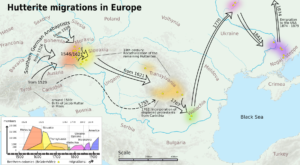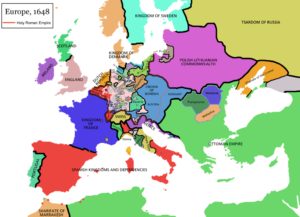Who were the Habáns, the Swiss immigrants fleeing to Hungary?

Refugees from Switzerland and Moravia arrived in Hungary and Transylvania during the 16th and 17th centuries.
Hutterites (German: Hutterer), also called Hutterian Brethren (German: Hutterische Brüder), are an ethnoreligious group that is a communal branch of Anabaptists who, like the Amish and Mennonites, trace their roots to the Radical Reformation of the early 16th century.
The founder of the Hutterite tradition, JacobHutter, established the Hutterite colonies based on the SchleitheimConfession, a classic Anabaptist statement of faith”.Following this confession of faith, Hutterite theology emphasizes credobaptism, a belief in the Church Invisible, Christian pacifism, and the rejection of oaths. The Hutterite Churches also believe in “a set of community rules for Christian living and the principle of worldly separation”. Hutterite communes, called “colonies”, are all rural; many depend largely on farming or ranching, depending on their locale, for their income. You can easily track their longhouses where entire families lived together.
The Habán were Hutterites, also Anabaptists, a sect of the Protestant faith, and they were dispelled from the west. We know that the Unitarian Church was in a strong position in Transylvania and elected King János Zsigmond, the first prince of the Transylvanian Principality was the only monarch in history who was a Unitarian.

Crowds of religious refugees fled to Transylvania and certain places of the “Hungaries” (I call the lands of Royal Hungary, Transylvania, and the Ottoman Occupied Lands like this) where they could find shelter: after the Diet of Torda in 1568, Transylvania accomplished the freedom of religions, first in Europe. Even in Royal Hungary, they were more tolerated than back home. The religious tolerance of Transylvania was an outstanding feature of the entire age. Also, it was the time when half of Royal Hungary became Protestant: it was a kind of resistance against the Catholic Habsburgs’ overpowering. The closer the lands of a landlord of Royal Hungary were to Transylvania, the more tolerant he was with the refugees.

The Hutterites (the followers of Hutter) first appeared in 1546 in Upper Hungary then many arrived in West Hungary. We talk about 80 settlements with 70,000 inhabitants. They lived in strict communities, shared their properties, and were excellent craftsmen. Their characteristic pottery revolutionized the ceramic art in the “Hungaries”. They made tin-glazed Faience pottery for the first time in Europe.

In 1593 the Long Turkish War aka the 15-Year War, which affected the Hutterites severely, broke out and lasted until 1606. In 1605, some 240 Hutterites were abducted by the Ottoman Turkish army and their Tatar allies and sold into Ottoman slavery during this war. You can read more about the events of this was on my page:
https://www.hungarianottomanwars.com/chronologie/the-fifteen-year-war-series-1591-1606/

Before the Hutterites could rebuild their resources the Thirty Years’ War (1618–1648) broke out and soon developed into a war about religion when in 1620 the mostly Protestant Bohemia and Moravia were invaded by Habsburg Emperor Ferdinand II, a Catholic, who annihilated and plundered several Hutterite settlements. But wasn’t the Calvinist Prince Bethlen Gábor of Transylvania his enemy?
The Hutterites had to leave Nikolsburg in 1621 and Prince Bethlen Gábor gave them a home in Alvinc, in Transylvania, near Gyulafehérvár (Alba Iulia). There were 186 of them in the first group and 1069 followed them soon. Sadly, the Habáns of Alvinc had suffered from Ottoman incursions during which the Bruderhof at Alvinc was burnt down in 1661.
Look at Alvinc on my page: https://www.hungarianottomanwars.com/transylvania/alvinc/

Prince Rákóczi György I of Transylvania also settled many of them in Sárospatak which is located in Royal Hungary.Habán’s culture began to decline after 1685 due to the “liberation” of Hungary that brought along great destruction and religious intolerance by the Habsburgs. We call the re-Catholized Hutterites “Habán” which is Habaner in German.
The Habsburgs made the remaining Habáns either re-Catholize or move to Russia or North America in the 18th century. By the end of World War II, the Haban group had become essentially extinct. Later, over 140 years in North America, the population living in a community of goods recovered from about 400 to around 45,000. Today, almost all Hutterites live in Western Canada and the upper Great Plains of the United States.

Their art greatly influenced Hungarian pottery, which was also being enriched by Ottoman ornaments in this age; basically, the traditional Hungarian ornaments were very similar to the Habáns’ art or the Turks’ in the first place.
You can see a few very nice pieces of their art in the pictures below.
Dear Readers, I can only make this content available through small donations or by selling my books or T-shirts.
If you like my writings, please feel free to support me with a coffee here:
You can check out my books on Amazon or Draft2Digital, they are available in hardcover, paperback, or ebook:
https://www.amazon.com/dp/198020490X
or at https://books2read.com/b/boYd81


My work can also be followed and supported on Patreon: Become a Patron!http://Become a Patron!





























